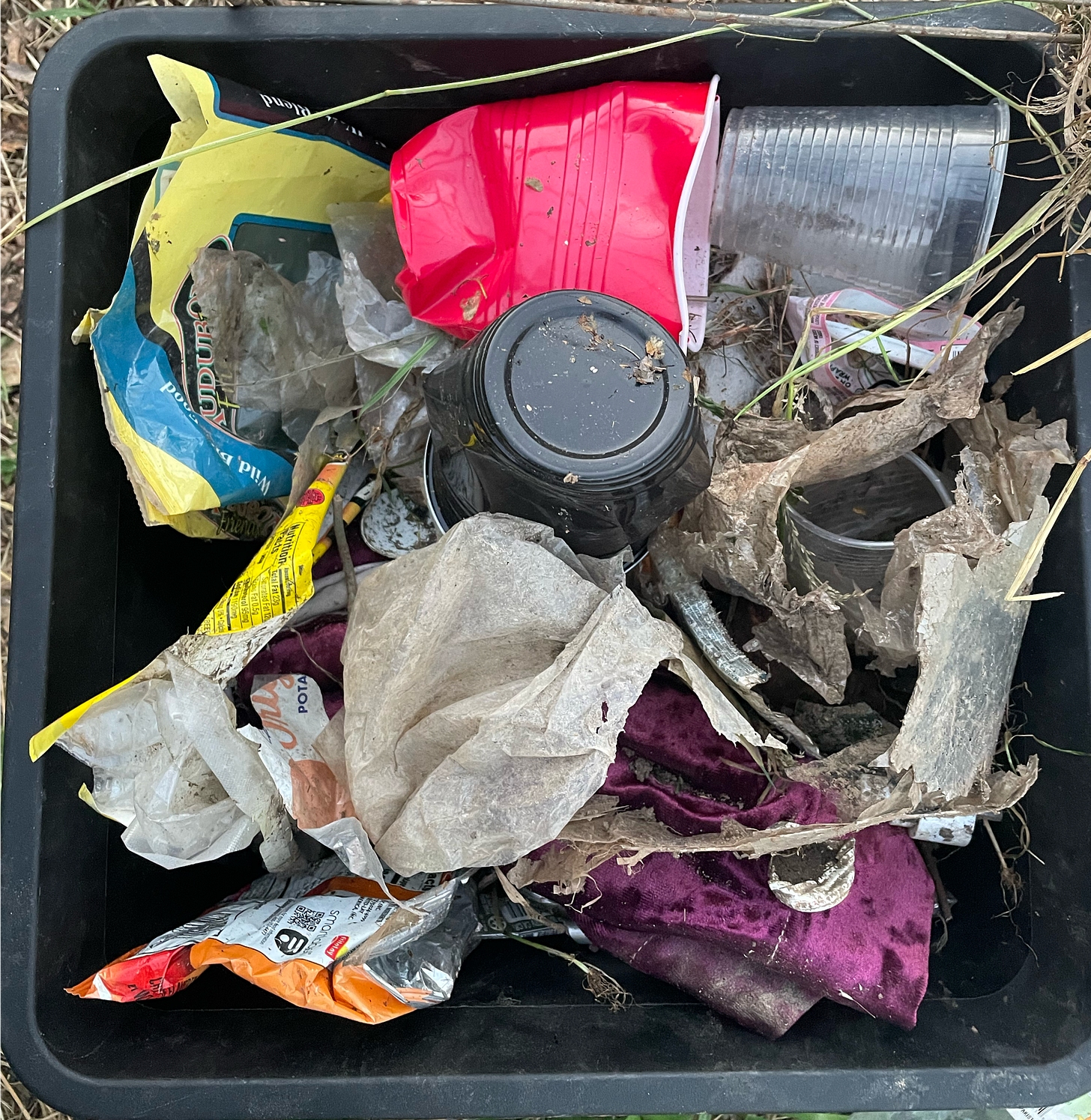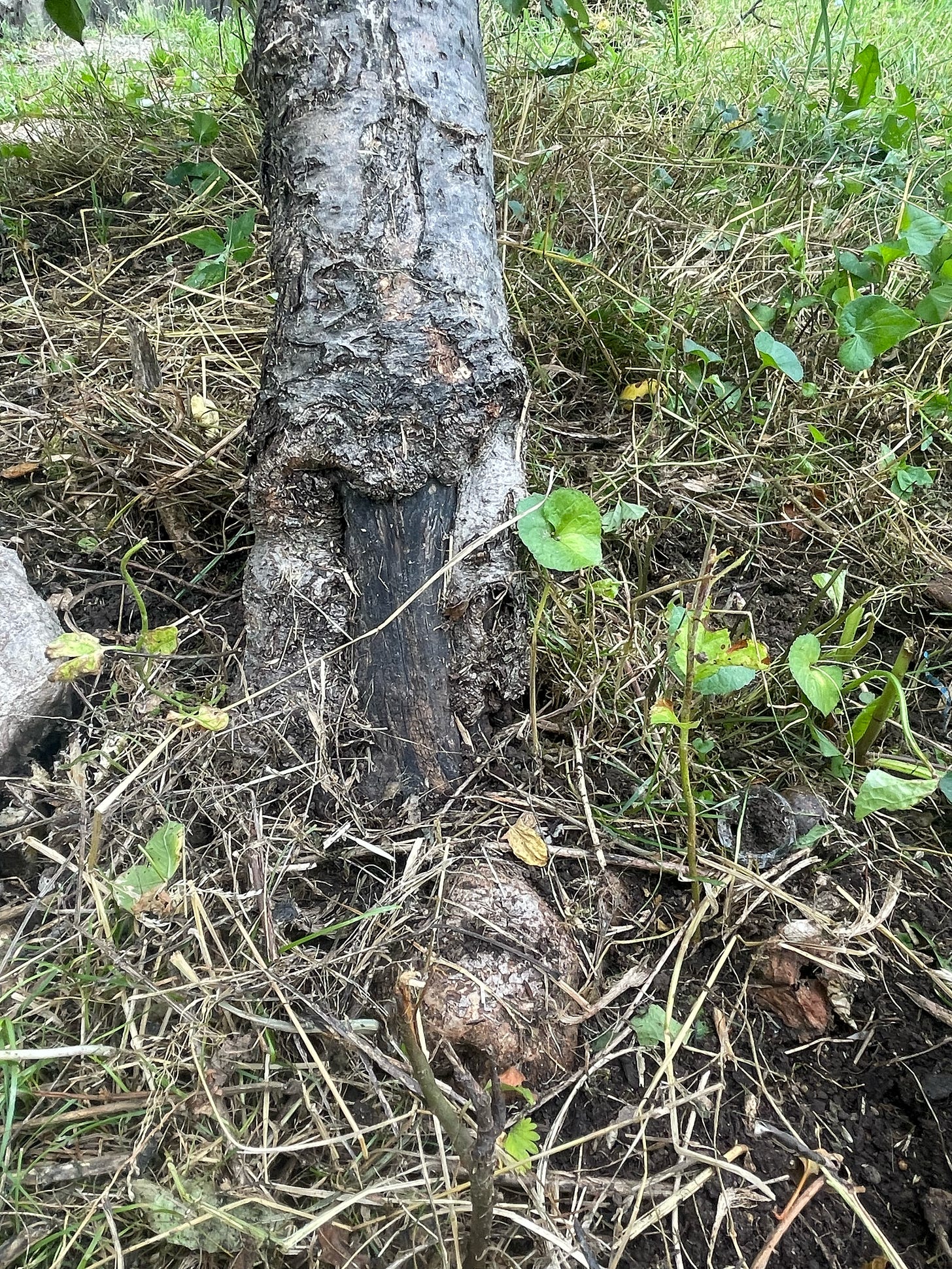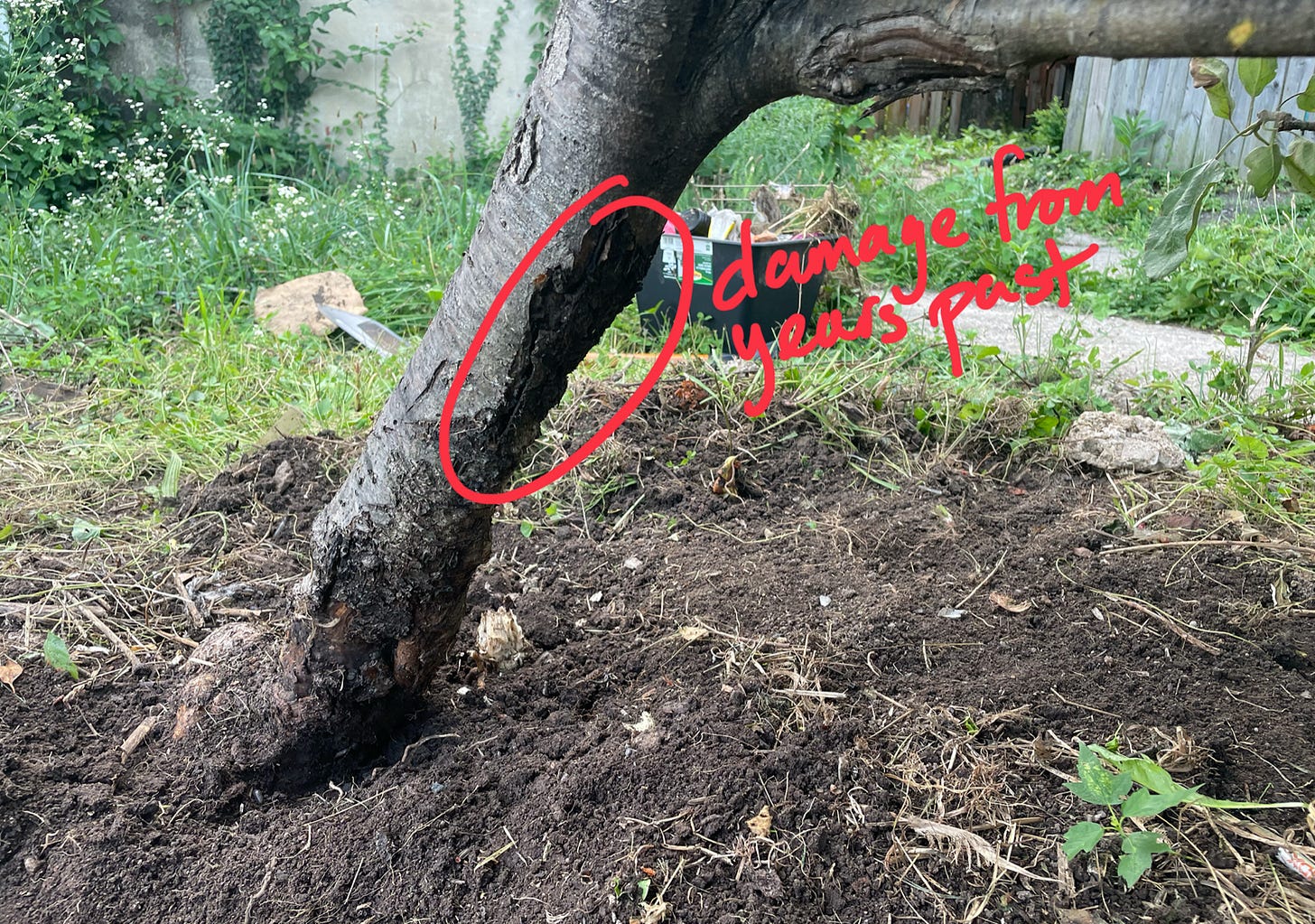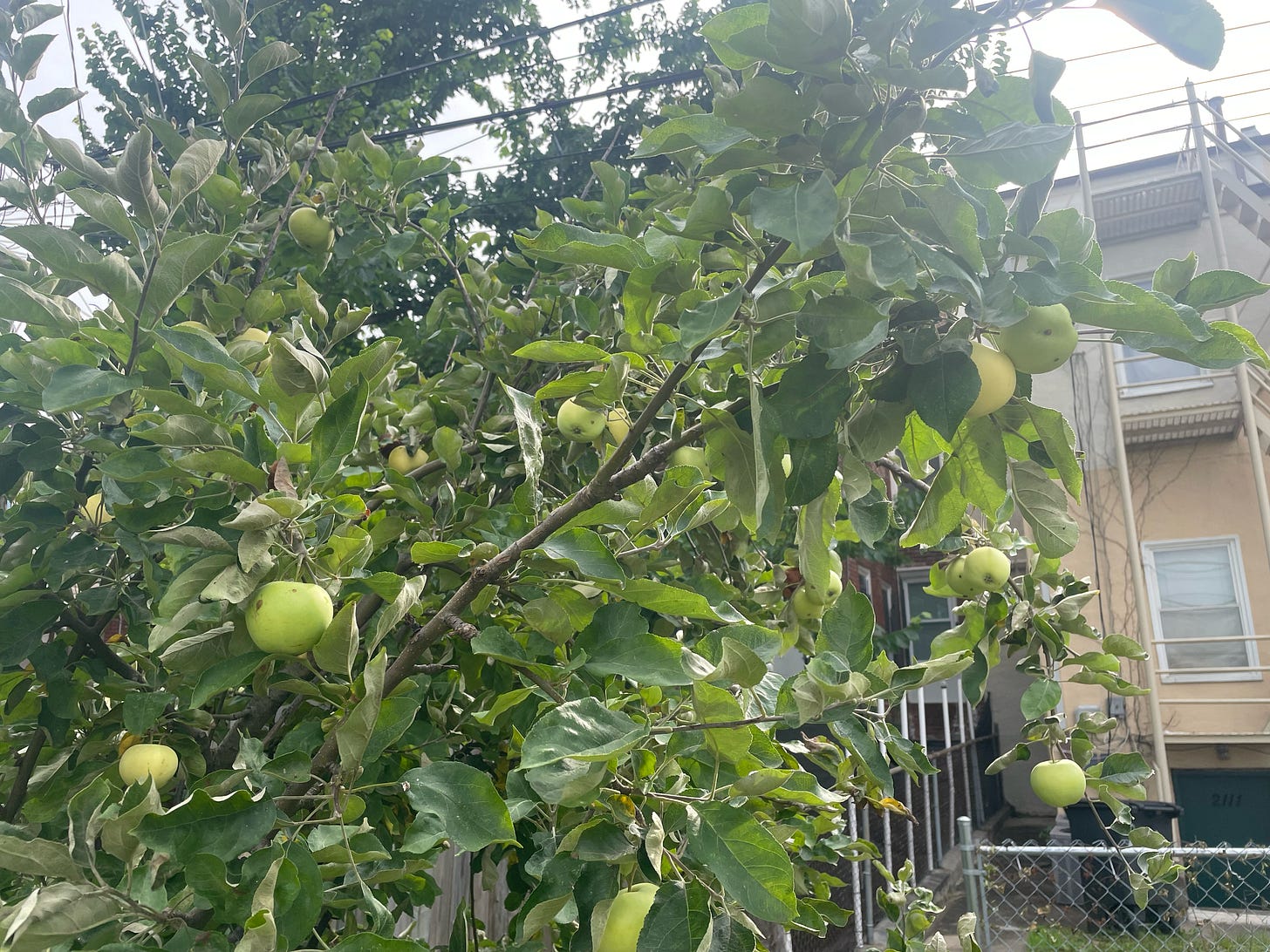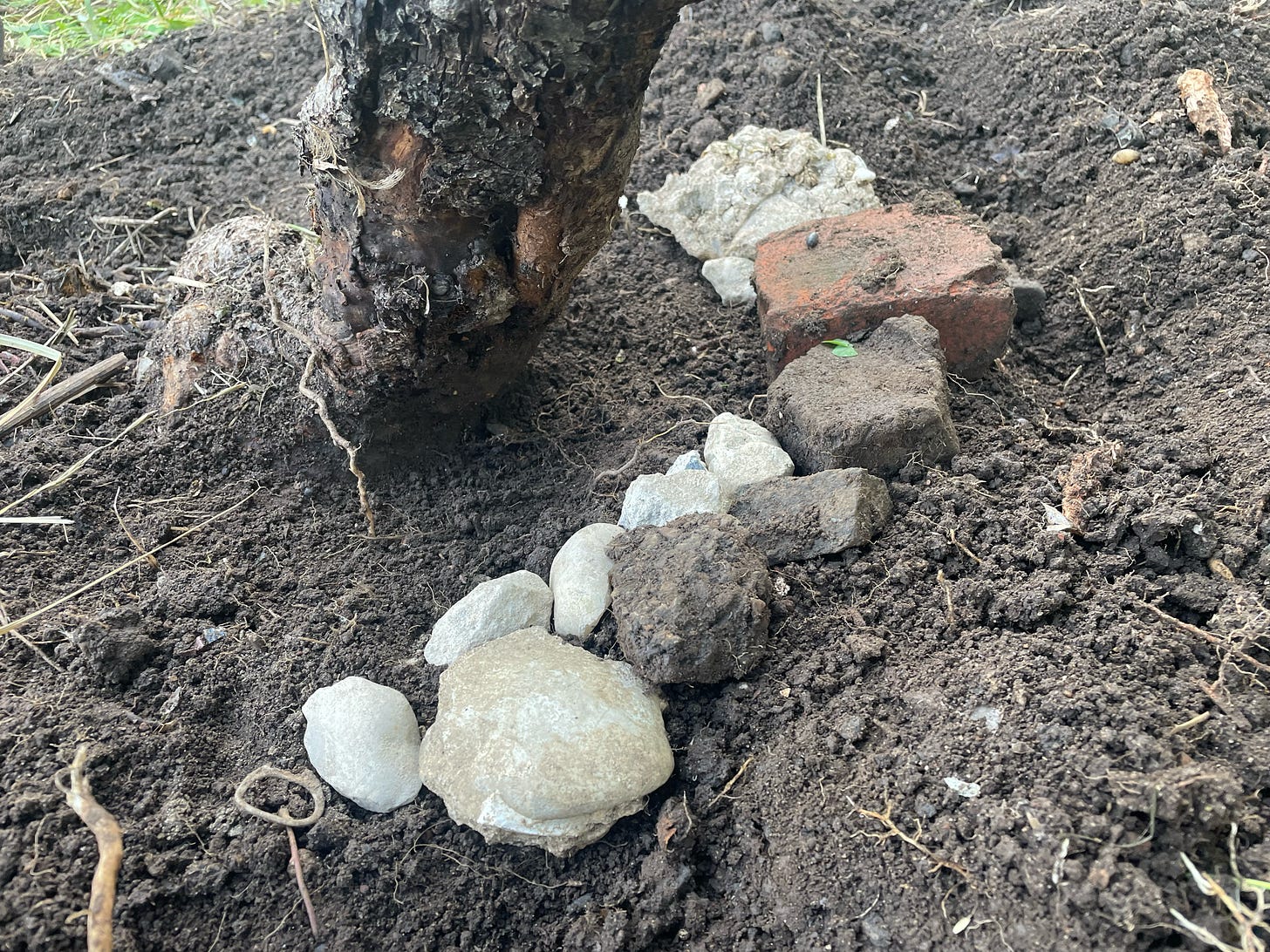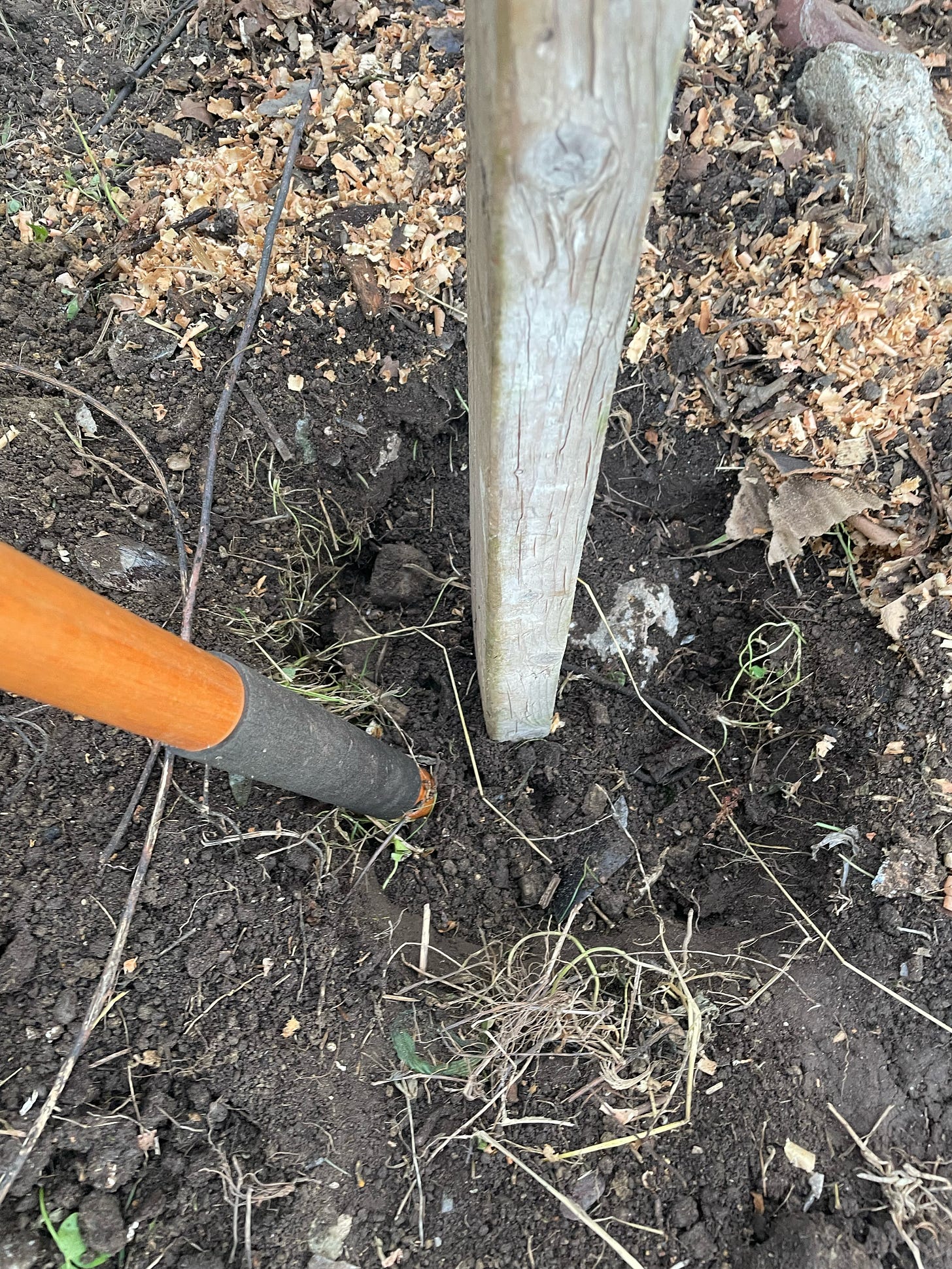Yesterday, I climbed out of a hole of despair.
Despair is easy to fall into. But it takes heavy lifting to build. Watching my country use my tax dollars—without any ability to say no—to bomb people is heavy lifting.
Triggering that despair though? Easy. There’s so much to push me there.
My country says it stands for freedom. But its actions—time and time again—prioritize domination over sovereignty. It doesn’t care about consent. It manufactures it with impunity.
The “land of the free” doesn’t even believe in freedom for its own people. “Labor for wages that we tax and use to build bombs—or starve” is not freedom.
But I don’t want to rant about my rage. My rage is too sacred to be used for anger. For despair.
Instead, I want to tell the story of how I climbed out of that hole.
Meet Defiance. She’s an apple tree in The Patch. I named her that because, though tiny for a tree and hunched hard at a forty-five degree angle, and wounded deeply at the base, she still bears more apples—bigger, heavier—than the two other trees on the lot, who are both double her size.
After eating her fruit, a couple of neighbors raised concerns about her well-being—understandably. Gravity can only be defied for so long. And no tree can lean forever without help.
Defiance was there before I started tending The Patch. I don’t know how old she is or who planted her, but judging by the damage to her core, care came too briefly—and was too quickly abandoned.
But I’m getting ahead of myself.
I couldn’t fix the damage my people were causing abroad—or the damage done at home.
So I figured, maybe I could fix this one tree.
Step 1: Clear the vicinity of rubbish
All kinds of waste lay scattered around. Someone had to do it.
The city cut the grass, but they didn’t pick up the trash.
Step 2: Pick up the rotting apples
This part was mostly for my comfort. The ground reeked of fermenting apples.
I briefly considered the possibility of saving the rotten fruit to make cider, as a science experiment. But I’d first have to figure out how to do it safely. Without going blind.
Fun science fact: the danger in homemade booze is methanol (CH₃OH), a one-carbon alcohol that boils at 64.7°C—just below the 78.4°C of ethanol (CH₃CH₂OH). Ethanol is the two-carbon alcohol that’s safe to drink (or at least, it’s not blindness-inducing).
Fewer carbons = lower boiling point. Distillers who know what they’re doing boil off the methanol first.
I, however, would not know what I’m doing. No cider for now.
Instead, I gathered the rotting apples and tossed them into the compost pile as not to be overwhelmed by their smell.
Step 3: Clear a three-foot radius
I took my machete and hoe and set to work around the base of the tree. Some of the grasses had been mowed, but not so well, so I hoed down the rest.
Still standing, though, inches from Defiance’s trunk, was the most-hated-by-naturalists tree in America: a Tree of Heaven. And it wasn’t alone. Clinging to its trunk were an infestation of the most-hated-by-naturalists bug in America: nymphs of the spotted lantern fly, those glowing-eyed emblems of ecological failure. Like the tree they feed on, they’re beautiful, invasive, and spreading fast.
Its roots ran deep and wide, surrounding the base of Defiance.
Step 4: Assess trunk damage
I had to diagnose the problem.
If a tree is rotten at its core, its prognosis isn’t good. And even before digging deeper, I could tell it wasn’t looking great.
From the scars on her trunk, the way the grass had been mowed around her base, and—yes—my current vitriolic bias against mowers since the city mangled The Patch like blundering brutes, I suspect the damage came from repeatedly slamming a lawnmower into her.
Crouching down, I checked the trunk by hand. The bark felt solid under my gloves, until—
—I hit a soft patch, and dozens of tree-boring beetles and ants spilled onto my hand. I leapt back, squealing with terror.
The heartwood was rotten.
That’s bad.
I know that’s bad because I panic-texted my arborist friend, who confirmed that’s bad. She used phrases like significant bark and trunk damage, decay, possible fungal infection, internal rot.
She asked me how attached I was to this tree.
Winter, she said, would probably damage it further. A strong wind next season could bring it down. From what she could tell from the video, the tree had one, maybe two seasons left.
“It’s not likely to thrive long-term.”
Yeah, well. Neither is the world, is it?
It was the middle of a heat wave. I looked up from my phone and took a breath. I was sweating through long sleeves and pants to keep off the Asian tiger mosquitoes—yet another invasive species, their extreme numbers a further symptom of ecological neglect.
I was thirsty. Every inch of me was wet with sweat.
My water bottle was too far away, left in the car. So I took an apple from the tree and bit into it. I expected the apple to be sour, but it wasn’t. It was just sweet enough. Juicy. Surprisingly refreshing. It didn’t cool me down, but my body thanked me for the bit of relief.
Then another text from my friend: it would be possible to help the tree limp along. Dry the wound, thin the canopy, stake it upright. Maybe prolong its life.
“But don’t expect heavy fruiting,” she wrote. “It’ll be using all its energy just to stay alive.
Those were the lines that got me.
I had only sent my friend close-ups of the damage—not a full picture of the tree.
She hadn’t seen the fruit.
She didn’t know Defiance was heavy with apples.
I’d do everything I could.
Step 5: Dry the rot
I slipped my gardener’s gloves on like they were my armor, the key to my courage. Then I got to work, clearing the soil from the rot, evicting the bugs that had made a home inside the wound, exposing it to fresh air.
I scoured the lot for stone and built a wall around the base—something to hold the soil back, keep the wound dry, protect it from the erosion of the next hard rain. I leveled the ground around her and carved channels so that water could drain instead of pool.
Thinking long-term, I laid down cardboard to suppress weeds and fend off any invasive seedlings. Then I blanketed the area with mulch.
Step 6: Find a brace
Luckily, it’s a vacant lot. Materials lie everywhere. Half-buried beneath the grass were several tall wooden beams. I pulled one free and, because I didn’t have a saw, used an axe to cut it down to size.
It needed to be tall enough to support a growing tree, but short enough to bring the center of gravity low, able to hold the weight without collapse.
Step 7: Dig a hole for the brace
This was my least favorite part.
I had a shovel, a hoe, a trowel—but the ground was so caked with human garbage, packed with broken bricks, shattered liquor bottles, and plastic nonsense, that digging felt like striking stone.
I had to stop, crouch down, excavate by hand. I felt like an archeologist after the apocalypse—excavating artifacts that testified not to a great civilization, but to a people who, on land taken through genocide of its natives, numbed themselves with drugs and trashed the empties right where they stood.
I ended up using a wooden stake to chisel through the compacted glass-soil, then cleared it bit by bit with a trowel.
At this step, I was too disgusted to feel sad.
Step 8: Place the brace
Eventually, I completed the job.
I had dug a three-foot hole which, even in ideal conditions, is more laborious than it sounds. And mine was just the right size.
I filled the hole in layers of rocks and soil, packing each down tightly, again and again, until the beam stood firm: six feet above ground, three feet below. When I tested it, it didn’t budge at all.
I was proud.
I learned to do that in the Philippines, from Kuya Oiyo, who built whole homes from bamboo—structures that could withstand brutal typhoon winds. Before concrete, that’s how people built: with renewable materials, easily repaired when damaged.
Kuya Oiyo had let me watch while he worked.
Step 9: Brace the tree
This part was the hardest.
The beam stood about four feet away from the highest part of the trunk, where the brace needed to go. I cut up an oversized cotton tee shirt, tied a bit of it around the tree to cushion the bark, then twisted the rest into a makeshift rope. I wrapped it around the trunk, stepped behind the beam, and pulled with all my strength.
The tree didn’t budge.
I wasn’t going to be able to do this alone.
So I walked out of the alley and knocked on the door of my friend Chris—one of the neighbors who had originally spoken up for Defiance.
He came with me, got under her leaning side, braced his shoulder against the trunk, and heaved.
We weren’t trying to fully upright the tree. That clearly would’ve been impossible, but even if it weren’t, trying could damage the roots. We just needed to ease the pressure on the trunk. Help her stand.
I lassoed the shirt around the trunk again and tied it to the beam. Chris heaved with all his might, pushing her a bit more upright, and I yanked hard to slide the knot closer and tighten the brace. We paused to catch our breath. Then again, heave. One more time, heave.
After the brace was in place, I tied as many knots as a could to hold it, until I ran out of shirt.
Then voila, we had done it.
Step 10: Relieve the weight
The last thing to do was lighten her load.
I picked the ripe apples around the edges of the tree so they wouldn’t add to the weight dragging her down.
As I worked, using my garden hoe to wiggle fruit from the uppermost limbs, a man passed by in the alley, walking with three kids. He stopped and stared. I was wearing a red plaid shirt and green safari hat to block the sun, standing in a vacant lot, using a hoe to prod apples from a tree. I suppose that’s not something you usually see in the middle of a city.
Instinctively, apples still in hand, I walked over to him.
“Are those apples?” he asked, eyes fixed on the fruit. I handed them to him and his kids.
“I’ve never noticed those before,” he said, thanking me.
There was more than enough to go around.
Tending Defiance took a lot longer than I had anticipated. The sun had already set by the time I packed up to go. I gathered tools, buckets, watering cans, and emptied the trash into city bins. I looked back at the lot—and was amazed.
Fireflies!
Those delicate creatures the headlines keep mourning as nearly gone, twinkled around Defiance.
This American land we have, like the land our bombs break overseas, has seen damage.
Our trees, once tied with rope for very different purposes, have seen incomprehensible cruelty.
For those who refuse to call the madness normal, who refuse to compartmentalize genocide and warmongering—what do we do?
We heal the land.
There’s a well-known story of a man who stood alone outside the White House, holding a candle night after night—for years. He began during the Vietnam War and continued until his death in 1967.
When asked by reporters, “Do you really think you’ll change them?”
He replied, “Oh, I don’t come here to change them. I come here so they don’t change me.”
He acted symbolically, so the normalization of violence wouldn’t erode his humanity.
My tree will die sooner than I had hoped. For Defiance, the damage to her foundation is too great to build a structure that could grow twenty feet tall and live however long well-tended trees are meant to live.
Defiance probably has, at most, three years left.
So may those years be filled with care. May she still bear fruit, feed the children, and grow—maybe not stories taller, but a few more feet at least.
She may not live as long as she once should have, but she’ll live more than she would have. And in her final years, she’ll live with care—with the knowledge that this was the best we could do with what we found. Defiance will die with grace.
Then years from now, after she’s wilted into soil, her wooden beam brace long since eaten by worms, the next make-shift archeologist to dig through that patch of land will find, buried among the garbage, a ring of stones placed intentionally at her base. A foundation. A brace. Something that once helped a wounded tree stand upright, for as long as she could.
People had cared.
I had climbed out of my hole of despair.
And when the time comes, we can take a scion graft of Defiance. A clone tree grown from one of her own limbs, genetically identical. Same apples, same taste. Rooted again. Her legacy carried forward.
I believe that death, when it comes naturally, can be a beautiful thing. That’s why we must not hasten it with violence.
Instead, we earn it—by tending life with care.





